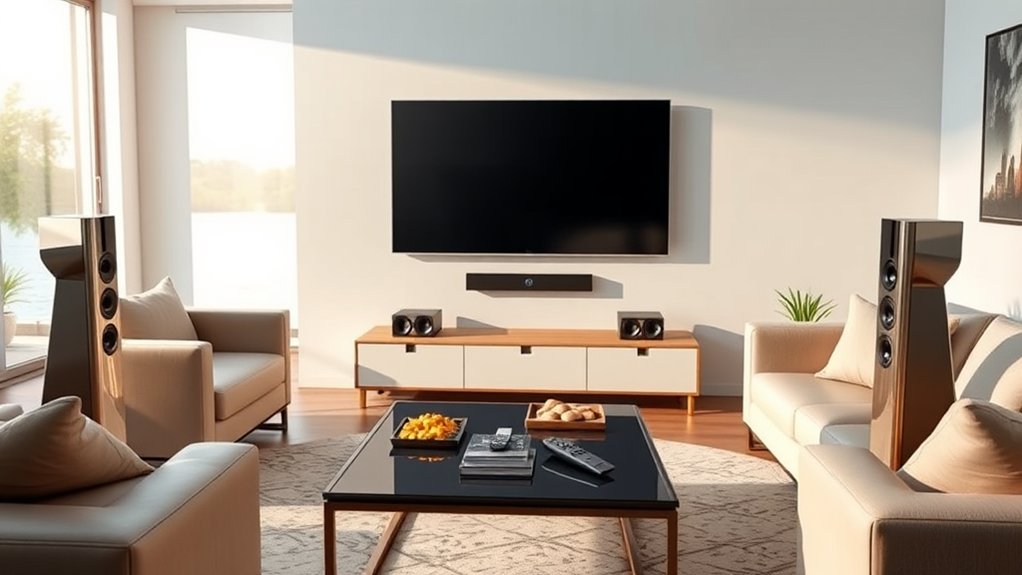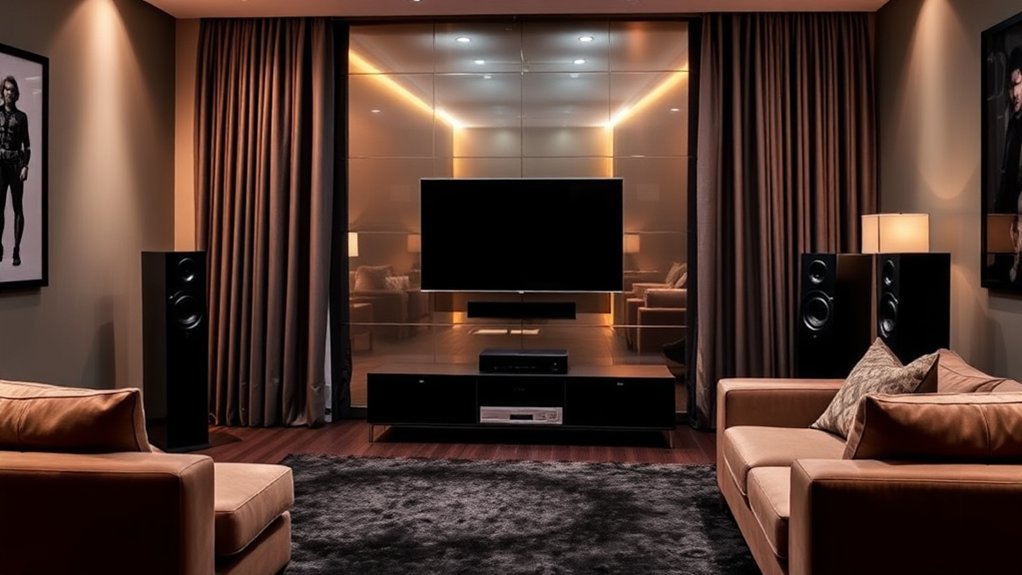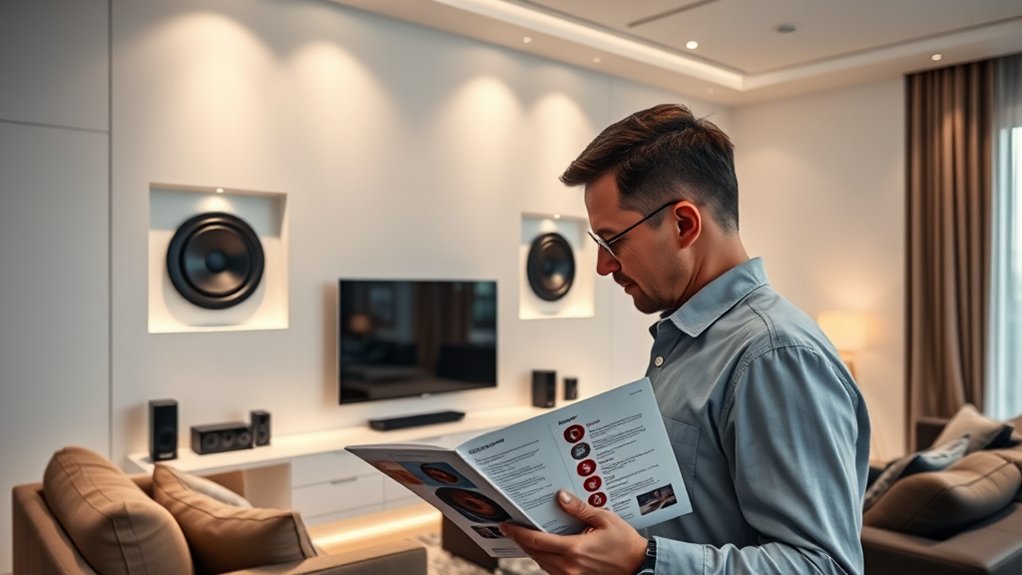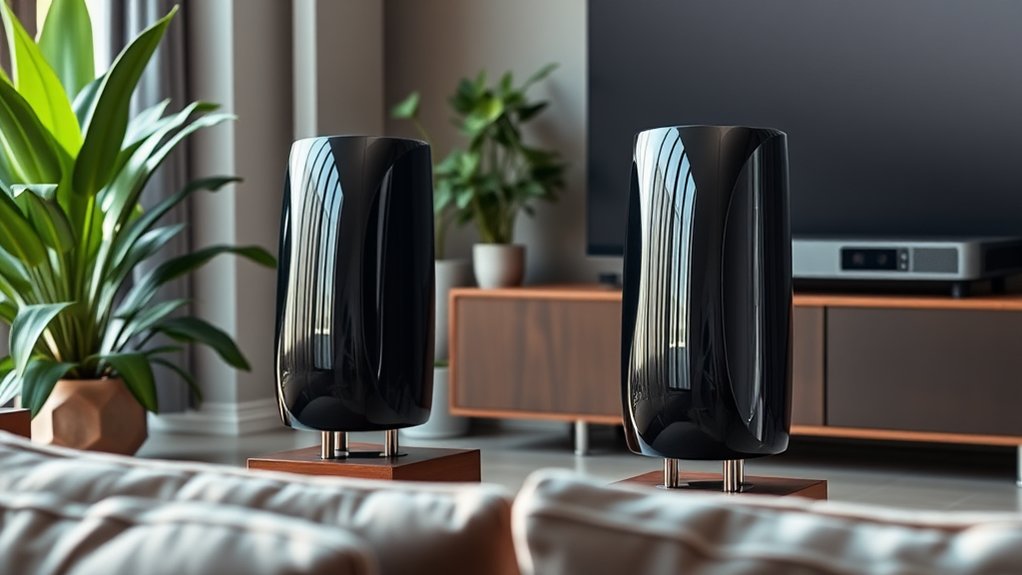To enhance your Bluetooth home theater experience, start by enabling Bluetooth for seamless connectivity, ensuring your source device pairs easily with your speakers. For the best sound, place your speakers in an equilateral triangle around your listening area, angling them slightly inward. Keep an eye on wireless interference, and consider prioritizing wired connections for crystal-clear audio. Finally, don’t forget about integrating smart devices or using remote controls to simplify your setup. Curious about fine-tuning your audio experience?
Key Highlights
- Activate Bluetooth on both the audio source and speakers, ensuring they are paired correctly to avoid connectivity issues.
- Position speakers in an equilateral triangle relative to your listening position for optimal sound delivery.
- Use wired connections like HDMI ARC for clearer audio clarity when possible, reserving Bluetooth for its portability.
- Regularly check and update device firmware for better compatibility and performance within your smart home ecosystem.
- Minimize interference by keeping Bluetooth devices close and avoiding physical barriers; switching Wi-Fi to the 5 GHz band is recommended.
Enable Bluetooth for Smooth Connectivity
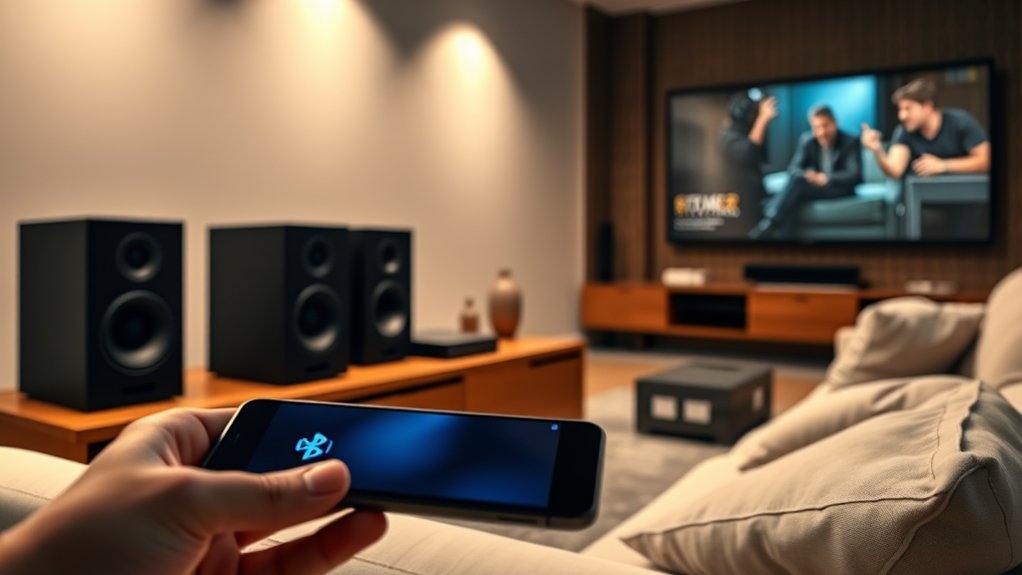
When you’re itching to plunge into your favorite movie’s soundscape, the first step is ensuring your Bluetooth connection is up and running smoothly.
Start by activating Bluetooth on your audio source, be it a smartphone or a laptop; you’ll usually find this in the settings menu. Once it’s on, your device should automatically search for your Bluetooth speaker, which typically appears with a recognizable name, like a model number. Stand within about 3 feet for the best signal. It’s important to be aware that Bluetooth technology is limited in streaming multiple audio channels, which can slightly affect the overall sound experience.
Once connected, you’ll often hear a charming audio prompt like, “Bluetooth is connected.” Now you can manage playback and volume using either the speaker or your device—talk about versatility! Additionally, ensure that your speakers are strategically placed for optimal room acoustics to fully immerse in the audio experience.
Once paired, enjoy a delightful prompt signaling connection, effortlessly controlling playback and volume from either your speaker or device.
Just remember, if things go sideways, toggling Bluetooth off and on can work wonders.
Optimal Speaker Placement for Best Sound
To achieve the best sound from your Bluetooth home theater speaker system, it’s essential to reflect on how you position your speakers throughout the space.
Start by creating an equilateral triangle between your front left and right speakers and your listening position; ideally, each side should range from 4 to 6 feet. Angle those speakers slightly inward for ideal sound focus, with your head about a foot behind the apex. Proper placement is critical for achieving good sound, so be mindful of the distances and angles. Additionally, understanding room acoustics will help you optimize the sound dynamics within your space.
For surround speakers, place them slightly behind you and at ear level for the best immersive experience.
And don’t forget about your subwoofer—it shouldn’t be crammed in a corner! So, do you really want to miss out on that booming bass?
Experiment to find what feels right for your room!
Managing Wireless Transmission and Interference
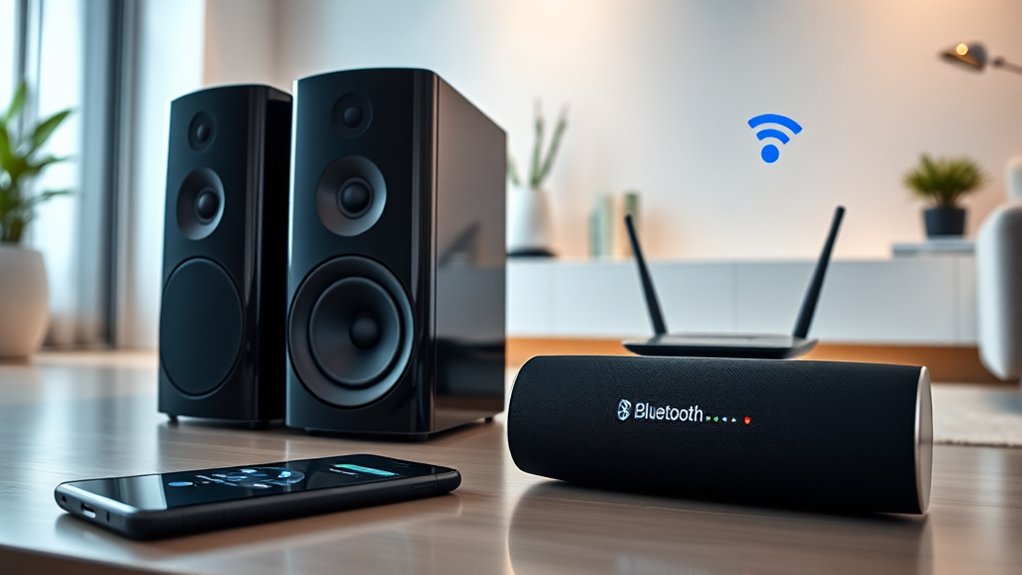
Managing wireless transmission and interference can feel like a game of signal chess, especially with multiple devices vying for your attention in your home theater setup.
Since Bluetooth and Wi-Fi typically operate on the same 2.4 GHz frequency band, it’s essential to minimize interference. Consider switching your Wi-Fi to the 5 GHz band, which helps keep your Bluetooth audio clear. Additionally, optimize your Wi-Fi channels to avoid overlapping frequencies. Identifying interference sources may require detailed observation to enhance your setup further. Wireless soundbars like the Sonos Beam offer compact designs that are perfect for saving space in your setup.
Switch to the 5 GHz band for Wi-Fi to keep your Bluetooth audio crackle-free and optimize channel settings to avoid interference.
Don’t forget about physical barriers—walls and metal objects can weaken signals. Keeping your Bluetooth components within 10 meters of each other is key, and positioning them away from appliances like microwaves really helps.
After all, you wouldn’t want your popcorn popping to ruin your movie’s soundtrack, right?
Fine-Tuning Audio With Sound Modes
Fine-tuning audio with sound modes can transform your listening experience dramatically, especially when you realize there’s a specific setting tailored for nearly every type of content you enjoy.
Whether you’re diving into a blockbuster movie, jamming out to your favorite tunes, or gearing up for an intense gaming session, modes like Dolby Surround and DTS provide immersive soundscapes.
Meanwhile, PCM multi-channel preserves the audio’s integrity without alteration.
If you’re seeking that concert feel, switch to Rock Arena or Jazz Club modes for an ambiance that transports you to a live venue.
Don’t forget direct modes; they offer pure audio fidelity, ensuring you hear exactly what the artist intended. Moreover, incorporating features like Dolby Atmos technology can significantly enhance your immersive experience further.
Prioritizing Connection Methods for Quality
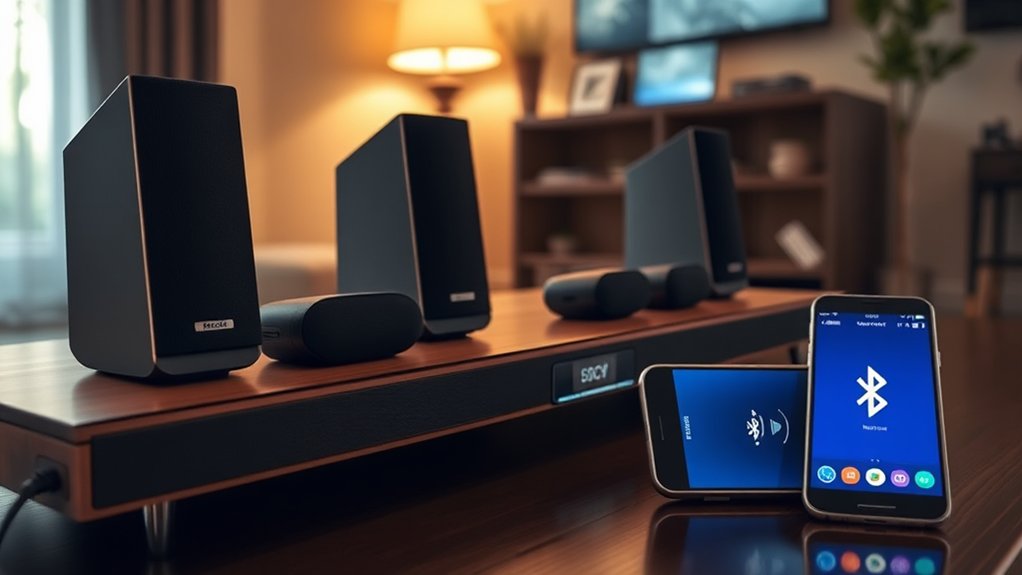
Though it might seem tempting to simply grab the easiest connection option for your Bluetooth home theater speaker system, understanding the various connection methods can significantly boost your audio quality.
Prioritize wired connections, like HDMI ARC or optical, for the best sound clarity and stability—think of it like choosing a direct line in a conversation.
If you’re dealing with larger spaces, Wi-Fi-based speakers allow for multi-room setups, but remember, your Wi-Fi’s reliability is essential here.
Bluetooth is fantastic for portability, but the trade-off typically involves some audio quality loss—sort of like using a tin can phone, right?
And don’t overlook proprietary wireless protocols, which can augment performance, reducing latency like a pro. Additionally, consider models that support advanced audio technologies, which greatly enhance the overall sound experience.
Experimenting With Subwoofer Location
In relation to crafting the ultimate listening experience in your home theater, where you decide to place your subwoofer can make all the difference—after all, who wouldn’t want that rich, booming bass that makes you feel like you’re right there in the action?
Start by positioning the subwoofer near your front speakers or along the front wall to better integrate with your soundstage. If you’re feeling adventurous, try the “subwoofer crawl” method, where you place it at your listening spot to find the best bass.
Manual Calibration for Personalized Audio
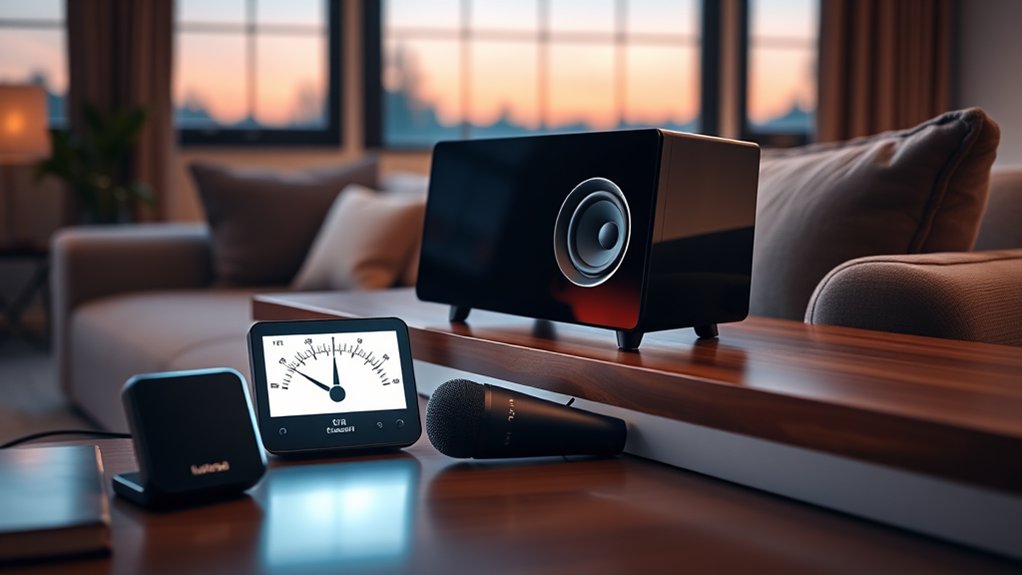
When you take the plunge into manual calibration, you’ll reveal a world of customization that auto setups just can’t match.
To start, make certain all speakers are connected and working; after all, it’s hard to calibrate a ghost! Measure speaker distances to your main listening position with a tape measure, inputting those exact figures into your AV receiver for precise time alignment.
Then, adjust individual speaker volumes to guarantee a balanced output. Don’t forget to check speaker sizes, as this impacts bass distribution considerably. Additionally, consider how the 3.1.2 channel system configuration can enhance your sound experience when calibrating.
Finally, engage in some fine-tuning with equalization to improve clarity and compensate for your room’s acoustics. By taking these steps, you’ll create a soundstage that’s distinctively tailored to your preferences.
Regularly Assessing Bluetooth Connection Health
Sometimes, people overlook the importance of regularly evaluating Bluetooth connection health, but keeping an eye on it can make a world of difference in your listening experience.
Start by ensuring Bluetooth is activated on both your speakers and the source device; without it, you’ll be as connected as a fish out of water. Verify your speaker is paired to the right device, too—some may play musical chairs, unexpectedly linking to the wrong source.
Regularly check your device lists to confirm connections, and feel free to test with different devices to pinpoint issues.
Furthermore, reducing interference from appliances nearby can work wonders. Remember, a little attention to your Bluetooth setup can help you avoid those annoying audio dropouts! For instance, knowing that audio formats supported by your speakers can aid in optimizing your playback quality.
Integrating Smart Home Devices for Enhanced Functionality
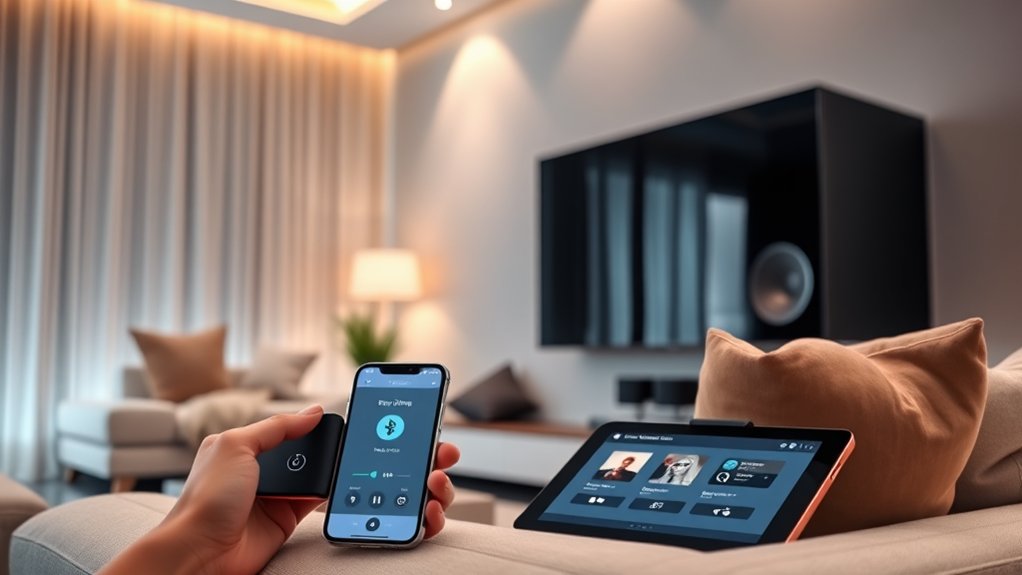
Integrating smart home devices into your Bluetooth home theater setup can raise your audio experience to a whole new level, making it not just about sound, but also about seamless interaction within your living space.
Start by selecting Bluetooth speakers that work with popular smart home ecosystems like Alexa or Google Assistant. This compatibility simplifies connectivity as well as allowing you to manage audio throughout your home effortlessly.
Imagine dimming the lights and adjusting the volume simply by asking your voice assistant—sounds nice, right? Plus, grouping speakers lets you enjoy synchronized sound across rooms.
And hey, don’t forget to check for ongoing firmware updates to keep everything running smoothly; who wouldn’t want a theater setup that evolves with technology?
Utilizing Remote Controls for Simplified Operations
A well-designed remote control can truly transform your Bluetooth home theater experience, making it feel like you’ve got the command center of an audio empire right in your living room.
Imagine this: with just one click, you can adjust the volume, switch inputs, or even initiate device pairing—no more running back to the speaker every time!
Advanced remotes come equipped with buttons for play, pause, and surround mode settings, as convenient LED indicators guide your hands in low light.
Plus, a wireless range of about 60 feet means you won’t need to stand like an awkward statue. Isn’t it nice when technology just… works?
With a little practice, you’ll navigate your audio kingdom like a pro, effortlessly controlling all your devices.
Frequently Asked Questions
Can I Connect Multiple Bluetooth Speakers to My TV Simultaneously?
You can connect multiple Bluetooth speakers to your TV simultaneously, but this is contingent upon your TV’s capabilities. Check for features like dual audio support, or consider using external transmitters for a more flexible setup.
How Do I Reset My Bluetooth Connection on the Speaker System?
To reset your Bluetooth connection, power on the speaker, locate the reset button, press and hold it for around ten seconds, then wait for confirmation signals that indicate the reset process has started successfully.
What Should I Do if My Bluetooth Connection Drops Frequently?
If your Bluetooth connection drops frequently, verify both devices have sufficient battery, reposition them within 30 feet, minimize signal interference, close unnecessary apps, and consider re-pairing or updating firmware for stable connectivity.
Are There Specific Brands Compatible With All Bluetooth Home Theater Systems?
You won’t find any brands that guarantee universal compatibility with all Bluetooth home theater systems. Nevertheless, some mainstream brands guarantee broad compatibility and pairing ease across various devices, enhancing your overall entertainment experience.
How Far Can I Place My Bluetooth Speakers From the TV?
You can place your Bluetooth speakers about 10 to 30 feet from the TV. Keep a clear line-of-sight to avoid connection issues, and test their position to confirm ideal sound quality and stability.

